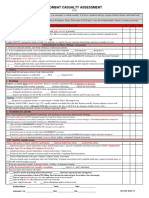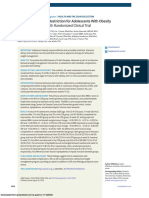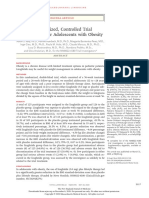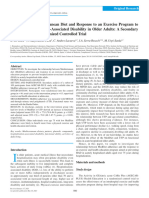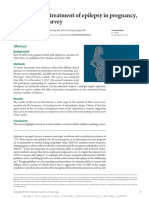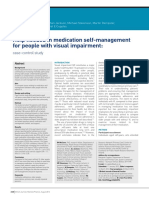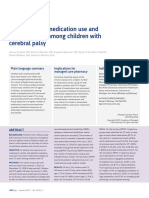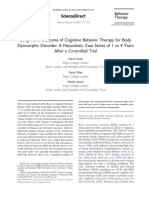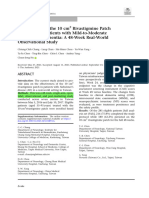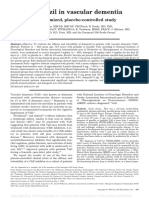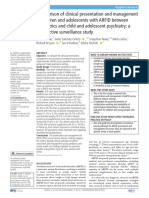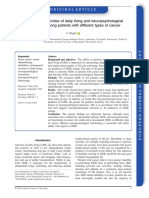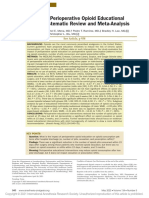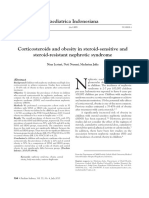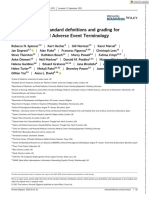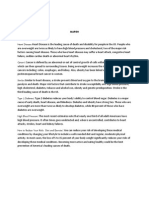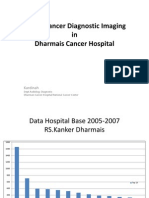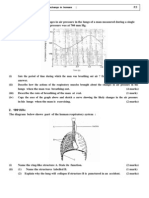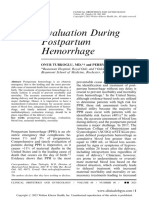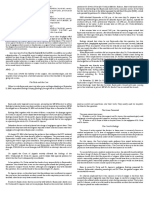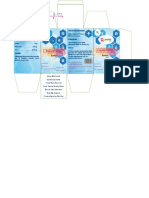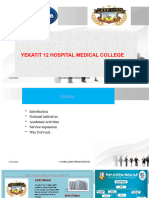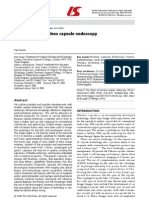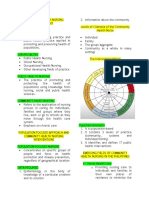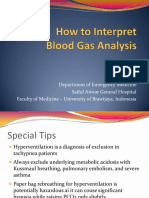WNL 2022 201574
WNL 2022 201574
Uploaded by
triska antonyCopyright:
Available Formats
WNL 2022 201574
WNL 2022 201574
Uploaded by
triska antonyOriginal Title
Copyright
Available Formats
Share this document
Did you find this document useful?
Is this content inappropriate?
Copyright:
Available Formats
WNL 2022 201574
WNL 2022 201574
Uploaded by
triska antonyCopyright:
Available Formats
RESEARCH ARTICLE
Safety, Efficacy, and Tolerability of Modified Atkins
Diet in Persons With Drug-Resistant Epilepsy
A Randomized Controlled Trial
Mala Manral, PhD, Rekha Dwivedi, PhD, Sheffali Gulati, MD, DM, Kirandeep Kaur, PhD, Ashima Nehra, PhD, Correspondence
Ravindra Mohan Pandey, PhD, Ashish Datt Upadhyay, PhD, Savita Sapra, PhD, and Manjari Tripathi, MD, DM Dr. Tripathi
mtripathiaiims@gmail.com
®
Neurology 2023;100:e1376-e1385. doi:10.1212/WNL.0000000000206776
Abstract MORE ONLINE
Background and Objectives Class of Evidence
Modified Atkins diet (MAD) has emerged as an adjuvant therapy in drug-resistant epilepsy Criteria for rating
(DRE). Most studies are in children; there is limited evidence for DRE in adults. This study therapeutic and diagnostic
studies
aimed to investigate whether MAD along with standard drug therapy (SDT) was indeed more
effective than SDT alone in reducing seizure frequency and improving psychological outcomes NPub.org/coe
at 6 months in adolescents and adults with DRE (nonsurgical).
Infographic
Methods links.lww.com/WNL/C685
A prospective randomized controlled trial was conducted at tertiary care referral center in India.
Persons with DRE aged 10–55 years attending outpatient epilepsy clinics between August 2015
and April 2019, who had more than 2 seizures per month despite using at least 3 appropriate
antiseizure medications (ASMs) at their maximum tolerated doses and had not been on any
form of diet therapy for the past 1 year, were enrolled. Patients were assessed for the eligibility
and randomly assigned to receive SDT plus MAD (intervention arm) or SDT alone (control
arm). The primary outcome was >50% reduction in seizure frequency, and the secondary
outcomes were quality of life (QOL), behavior, adverse events, and rate of withdrawal at
6 months. Intention-to-treat analysis was performed.
Results
A total of 243 patients were screened for eligibility; 160 patients (80 adults and 80 adolescents)
were randomized to either the intervention or control arm. Demographic and clinical char-
acteristics in both groups were comparable at baseline. At 6 months, >50% seizure reduction
was seen in 26.2% in the intervention group vs 2.5% in the control group (95% CI 13.5–33.9;
p < 0.001). Improvement in QOL was 52.1 ± 17.6 in the intervention group vs 42.5 ± 16.4 in the
control group (mean difference, 9.6; 95% CI 4.3 to 14.9, p < 0.001). However, behavior scores
could be performed in 49 patients, and improvement was seen in the intervention vs control
group (65.6 ± 7.9 vs 71.4 ± 8.1, p = 0.015) at the end of the study. One patient had weight loss;
2 patients had diarrhea.
Discussion
The MAD group demonstrated improvement in all aspects (reduction in seizure frequency and
behavioral problems) compared with the control group at the end of the study. MAD is an
effective modality in controlling seizures; further research is required to assess its efficacy in
terms of biomarkers along with descriptive metabolomics studies.
Trial Registration Information
The clinical trial registry of India: CTRI/2015/07/006048.
From the Departments of Neurology (M.M., R.D., K.K., M.T.), Paediatrics (S.G., S.S.), All India Institute of Medical Science; Neuropsychology (A.N.), and Biostatistics (R.M.P., A.D.U.), All
India Institute of Medical Science, New Delhi.
Go to Neurology.org/N for full disclosures. Funding information and disclosures deemed relevant by the authors, if any, are provided at the end of the article.
e1376 Copyright © 2023 American Academy of Neurology
Copyright © 2023 American Academy of Neurology. Unauthorized reproduction of this article is prohibited.
Glossary
AIIMS = All India Institute of Medical Sciences; ASMs = antiseizure medications; DRE = drug-resistant epilepsy; ILAE =
International League Against Epilepsy; ITT = intention to treat; MAD = modified Atkins diet; PP = per protocol; QOL =
quality of life; RCTs = randomized controlled trials; SDT = standard drug therapy.
Classification of Evidence
This study provides Class III evidence that the MAD increases the probability of seizure reduction in adolescents and adults
with DRE.
Epilepsy affects more than 70 million people worldwide, and nonsurgical patients with DRE?” The secondary objectives
one-third of persons with epilepsy are resistant to antiseizure were to determine the quality of life, behavior, tolerability of
medications (ASMs).1 MAD, and their adverse effects at 6 months among adolescents
and adults with DRE.
Drug-resistant epilepsy (DRE) is defined by the International
League Against Epilepsy as “failure of adequate trials of 2
tolerated, appropriately chosen, and used ASM schedules Methods
(whether as monotherapy or in combination) to achieve Trial Design and Oversight
sustained seizure freedom.”2 Many patients who are not A prospective randomized open-label, blinded endpoint
suitable surgical candidates or decline surgery3 have benefited controlled trial with 2 parallel arms design was conducted in
from dietary interventions.4,5 the pediatric and adult neurology clinic, All India Institute
of Medical Sciences (AIIMS), a tertiary care referral center
Modified Atkins diet (MAD) aims to provide increase palat- in New Delhi, India. Eligible participants were randomly
ability and flexibility with a 1:1 ratio of fat to carbohydrates assigned to receive the SDT plus MAD or SDT alone in a 1:
and protein, as it has around 65% fat, 25% protein, and 10% 1 ratio. All the patients underwent clinical evaluations at
carbohydrates.6 MAD and low glycemic index diet (LGIT) baseline, 3 months, and 6 months, and outcome assessment
are hence less restrictive alternatives to the ketogenic diet was performed at 6 months. Structured formats of seizure-
(KD), as protein and calories are not restricted.7 log, ketone-log, food-log, adverse event diary, and schedule
of enrollment and timeline of clinical evaluations
In previous studies, nearly half the patients with DRE showed (eFigure 1A, 1B) are provided in eAppendix 1 (links.lww.
>50% seizure reduction on the KD, and about 15%–20% com/WNL/C564).
became seizure-free.8 A meta-analysis showed that the com-
bined efficacy rates for freedom from seizures, reduction of Standard Protocol Approvals, Registrations,
seizures by 50% or more, and reduction of seizures below 50% and Patient Consents
in adults with difficulty to treat epilepsy was 13%, 53%, and The institutional ethics committee approved this trial, and
27%, respectively.9 Several studies have shown an efficacy of written informed consent was obtained from adults, parents, or
MAD of at least in 30% of the study patients having >50% the legally authorized representatives of the adolescent patients
reduction in seizure.10-14 The efficacy of MAD has been with DRE, before recruitment. This trial was registered with the
established and well tolerated in children with DRE.13,15,16 Clinical Trial Registry of India [(CTRI); ref no. CTRI/2015/
Evidence suggests that MAD may have comparable efficacy 07/006048]. The report of the study follows the CONSORT
but a higher rate of compliance as compared to KD in adults guidelines.23
with DRE.17-20 There is an uncertainty as to the best dietary
treatment because of a low number of trials in adults with Participants
DRE.21,22 Therefore, we chose MAD because of its ease of The detailed study flowchart is presented in Figure 1. Potential
applicability and better compliance than the KD and the need candidates were recruited from the pediatric and neurology
for randomized controlled trials (RCTs) for assessing long- epilepsy clinic of tertiary care referral center, New Delhi. We
term outcomes with regard to the response to MAD in a larger enrolled patients who met the following inclusion criteria: (1)
cohort, including adolescents and adults with DRE, which are age [10–55 years; adolescents (10 to ≤18 years) and adults
still lacking. (>18–55 years)], (2) DRE who had more than 2 seizures per
month despite using at least 3 appropriate ASMs at their
We therefore performed a RCT. Our primary research ques- maximum tolerated doses,21 and (3) agreed to regular follow-
tion was to investigate “whether the addition of MAD (dietary up and maintain their seizure-log. Patients were excluded in the
intervention) with on-going standard drug therapy (SDT) is following conditions: (1) surgical candidates, (2) an inborn
more efficacious in terms of seizure control at 6 months in the error of metabolism, clinical suspicion of metabolic disorder4
Neurology.org/N Neurology | Volume 100, Number 13 | March 28, 2023 e1377
Copyright © 2023 American Academy of Neurology. Unauthorized reproduction of this article is prohibited.
Figure 1 Study Flowchart
ABCL = Adult Behavior Checklist; CBCL = Child Behavior Checklist.
known as chronic systemic disorder, (3) intake of any dietary maintain a daily seizure-log by recording the seizure type, du-
therapy in the past, and (4) refusal to give consent. The screening ration, and frequency before enrollment. In the run-in period,
procedure was performed with the assistance of the concerned no special dietary restrictions were advised. All baseline de-
clinicians (M.T. and S.G.). All patients underwent a 4-week mographic details, biochemical investigations, and clinical details
observation period (week -4 to week 0 [the weeks are labeled -4 were collected in the paper-based standard case report form and
to 0] [run-in period]). Parents/caregivers were asked to then entered in an excel datasheet after the run-in period.
e1378 Neurology | Volume 100, Number 13 | March 28, 2023 Neurology.org/N
Copyright © 2023 American Academy of Neurology. Unauthorized reproduction of this article is prohibited.
Randomization and Blinding included tolerability and adverse effects of the diet as per
Patients were randomly assigned to either of the 2 parental/caregivers’ reports. We also compared changes in
groups—SDT plus MAD (intervention arm) or SDT alone biochemical parameters, QOL, and behavior from baseline to
(control arm). Computer-generated permuted blocks strati- 6 months using QOL in Epilepsy Inventory for Adolescents-
fied by age group were used to generate a randomization list. 48 and QOL in Epilepsy Inventory-31 for adults. Both scales
Allocation concealment was performed using sealed and se- contain questions about health-related quality of life. Child
rially numbered opaque envelopes. These envelopes were Behavior Checklist and Adult Behavior Checklist scales were
prepared by a person not involved in the study (R.D.). A used for the behavioral assessments, which were completed by
dietician (M.M.) was directly involved with the diet pre- parents/caregivers in each visit. Patients were followed up and
scription, and patients and their caregivers were not blinded assessed using daily seizure-log, food-log, and ketone-log at 1
to the treatment, seizure frequency, and adverse events related month, 3 months, and 6 months.
to the treatment. The primary outcome assessor (K.K.) was
blinded to the treatment allocation. Secondary outcome as- Safety
sessors (S.S. and A.N.), clinicians (M.T. and S.G.), other An independent, external data safety monitoring board
personnel (R.D.), and statisticians (R.M.P. and A.U.) were (DSMB) (Acknowledgement section) reviewed all the pa-
also blinded to the group allocation. tients’ case record files periodically for their safety, efficacy,
and adverse events. We followed DSMB guidelines.25
Intervention and Control
After the run-in period (−4 weeks), MAD therapy was started Statistical Analysis
on an outpatient basis. Carbohydrate intake was restricted to The sample size was calculated based on an anticipated de-
20 g/d. The detailed MAD protocol, a standard food ex- crease of >50%13,17 for the SDT plus MAD group as com-
change list, sample menu, and recipe booklet of standardized pared to the SDT group. Expecting a 30% response rate in the
recipes including Indian recipe with either 2.5 g or 5 g car- intervention arm and 10% in the control arm, power of 80%,
bohydrate are provided in eAppendix 2, links.lww.com/ and level of significance 5%, a sample size of 144 (72 each
WNL/C564. High-fat and low-carbohydrate foods were en- group) was calculated. Considering that 10% of patients
couraged; however, proteins were unrestricted. The diet was might be lost to follow-up at 6 months, 160 patients were
supplemented with multivitamins and minerals. Parents and enrolled in total.
caregivers were taught to maintain a daily-log of seizure count,
meals consumed in a day, dietary intolerance, and urine ke- All statistical analyses were conducted using STATA (Version
tones (thrice a day) using color-coded keto dipsticks. Average 14, Stata Corp; College Station, TX). Variables were checked
ketosis was calculated after 24 weeks of diet. Any adverse for normal distribution, and frequency (percentage), mean, or
effects (i.e., constipation, diarrhea, weight loss, anorexia, median values were used as appropriate. Categorical and
lethargy, vomiting, sleep, disturbance, and hospitalization due continuous variables were computed using the χ 2 test/Fisher
to MAD) were noted as per parental/caregivers’ interview at exact and unpaired t test or the Wilcoxon-Mann-Whitney test.
each visit at 15 days after the diet initiation, 3 months, and 6 Owing to skewness, the variables (i.e., SGPT and triglycer-
months. Diet compliance was assessed based on carbohydrate ides) were log-transformed and appropriate test applied. Log-
consumption recorded in the daily food-log. Consumption of binomial regression was used to see the effect of intervention
carbohydrates was calculated by using DietCal software.24 after adjusting the variables, which were not comparable at
Regular telephonic consultation was given weekly to ensure baseline. For the primary outcome, percentage reduction on
adherence to the diet. seizure frequency at 6 months was analyzed using effect size
(mean or median difference) with 95% CI, and relative risk
The control group received a normal diet with no specific (RR with 95% CI) was also analyzed to see the risk between
dietetic inputs. A trained dietician (M.M.) provided coun- the 2 treatment groups. Intention-to-treat (ITT) analysis was
seling to the caregivers along with age and weight-specific performed by including all patients who were enrolled and
dietary charts based on the Recommended Dietary Allowance assigned to an intervention. Patients who could not be con-
without any carbohydrate restriction. Prescribed ASMs were tacted at 6 months and their outcome data were missing; the
not changed during the study period in both the groups. The last observation carried forward method was used for primary
complete blood count and fasting lipid profile at baseline and and secondary outcome analyses. Per-protocol (PP) analysis
follow-up at 6 months were measured. After 6 months, MAD was performed for patients who assigned the allocation and
was offered to those who wanted to follow the therapy. who adhered to the protocol at 6 months. The effect of diet on
seizure reduction was analyzed using worst-case scenario
Outcome Measurements analysis. Adverse effects of the intervention were summarized
The primary outcome measure was the proportion of patients as number (percentage), and p < 0.05 was considered statis-
with greater than 50% seizure reduction (seizure frequency) tically significant.
from baseline to 6 months of follow-up in both groups. Sei-
zure frequency was measured as the average seizures/week in The study protocol and statistical analysis plan are available in
the preceding 4-week period. Secondary outcome measures eSAP 1, links.lww.com/WNL/C563.
Neurology.org/N Neurology | Volume 100, Number 13 | March 28, 2023 e1379
Copyright © 2023 American Academy of Neurology. Unauthorized reproduction of this article is prohibited.
Results (Table 1). The median of the baseline seizure frequency was
similar in both groups (intervention: 16.5 and control: 24.0; p =
Baseline Characteristics 0.88). Most of the patients had epilepsy of structural (MAD:
A total of 243 patients with DRE were screened for eligibility 52.5%, SDT: 57.5%) or unknown etiology (MAD: 45.0%,
between August 2015 and April 2019; 160 patients were en- SDT: 40.0%). Most patients were on at least 4 or more ASMs,
rolled and randomly assigned to the intervention (n = 80) or the frequent of these being levetiracetam (MAD: 60.0%, SDT:
control (n = 80) group. Fifty-two patients withdrew from the 70.0%), valproate (MAD: 75.0%, SDT: 75.0%), and clobazam
study, and the remaining 108 patients (46: intervention and (MAD: 62.5%, SDT: 55.0%) (eFigure 2, links.lww.com/WNL/
62: control) who completed 6 months of follow-up were in- C564). Nonvegetarians were higher in both groups (MAD:
cluded for the per-protocol analysis. The reasons for the pa- 65.0%, SDT: 58.7%) as compared to vegetarians (MAD:
tient’s withdrawal and exclusion from the study are given in 35.0%, SDT: 41.2%) (eFigure 3, links.lww.com/WNL/C564).
the CONSORT chart (Figure 2).
Urine ketone levels were moderate to high (40–80 mg/dL)
The demographic and clinical characteristics of the patients throughout the study period. The mean morning and evening
were comparable at baseline except for gender (p = 0.006) levels of urine ketosis among the patients in the diet group were
Figure 2 CONSORT Flowchart of the Study
MAD = modified Atkins diet; SDT= standard drug therapy.
e1380 Neurology | Volume 100, Number 13 | March 28, 2023 Neurology.org/N
Copyright © 2023 American Academy of Neurology. Unauthorized reproduction of this article is prohibited.
Table 1 Baseline Demographic and Clinical Details of All Patients With DRE
Intervention group Control group
Baseline characteristics (n = 80) (n = 80) p Value
Age at enrollment (in years)a 19.5 ± 7.4 19.4 ± 7.1 0.92
Gender, n (%) 0.006
Male 64 (80) 48 (60)
Female 16 (20) 32 (40)
Weight (in kg) 58.9 ± 19.8 59.6 ± 19.9 0.81
2
BMI (kg/m ) 22.5 ± 5.8 23.5 ± 6.2 0.28
Age at first seizure (in years) [median (IQR)] 5.5 (2.0–8.5) 6.5 (3–10) 0.28
a
Duration of epilepsy (in years) 12.9 ± 6.3 11.7 ± 5.7 0.24
No. of seizures per month [median (IQR)] 37.5 (11.0–75.0) 26.5 (6.5–72.5) 0.10
No. of ASMs tried in the past months [median (mean ± SD)]a 4 (4.0 ± 0.9) 4 (4.1 ± 0.9) 0.86
Seizure type (%) 0.31
Tonic 2 (2.5) 5 (6.3)
Atonic 3 (3.7) 1 (1.2)
Focal seizures 33 (41.3) 43 (53.8)
Generalized tonic-clonic seizures 27 (33.7) 23 (28.7)
Myoclonic jerks 10 (12.5) 5 (6.3)
Multiple seizure types 5 (6.3) 3 (3.7)
Etiology, n (%) 0.86
Structural 42 (52.5) 46 (57.5)
Infectious 2 (2.5) 2 (2.5)
Unknown 36 (45.0) 32 (40.0)
a
Levels of biochemical parameters
Uric acid, μmol/L 4.3 ± 1.4 4.3 ± 1.3 0.99
SGOT, mmol/L 26.7 ± 9.9 26.1 ± 8.3 0.93
SGPT, mmol/L 30.6 ± 18.6 26.1 ± 10.5 0.13
Total cholesterol, mmol/L 170.0 ± 41.5 171.7 ± 40.5 0.79
LDL, mmol/L 103.3 ± 36.4 105.3 ± 35.6 0.73
HDL, mmol/L 49.7 ± 10.4 47.8 ± 16.5 0.39
Triglycerides, mmol/L 106.9 ± 54.3 115.4 ± 52.2 0.18
Quality of lifea 44.1 ± 15.6 46.7 ± 15.2 0.29
Behavior problems (T scores)a 71.2 ± 6.3 (n = 23) 69.8 ± 9.1 (n = 26) 0.56
(n = 49)
Abbreviations: IQR = interquartile range; intervention group = standard drug therapy (SDT) plus modified Atkins diet (MAD); control group = SDT alone; ASMs =
antiseizure medications; BMI = body mass index; LDL = low-density lipoprotein; HDL = high-density lipoprotein; SGOT = serum glutamic oxaloacetic trans-
aminase; SGPT = serum glutamic pyruvic transaminase.
a
Data are represented as mean ± SD.
58.3 ± 8.0 mg/dL and 62.2 ± 22.6 mg/dL, respectively, in- Primary and Secondary Outcomes
dicating satisfactory adherence to the diet. Baseline demographic At the end of the study period, the proportion of patients
and clinical details were obtained for adolescents and adults with >50% seizure reduction from baseline was significantly
(eTables 1 and 2, links.lww.com/WNL/C564). higher in the intervention group (Table 2) as per both ITT
Neurology.org/N Neurology | Volume 100, Number 13 | March 28, 2023 e1381
Copyright © 2023 American Academy of Neurology. Unauthorized reproduction of this article is prohibited.
Table 2 Efficacy of Diet in Seizure Frequency at the End of Treatment (6 Months) in All Patients
Seizure reduction Intervention group Control group Proportion difference (95% CI) RR (95% CI) p Value
A) ITT analysis [SDT plus MAD group (n = 80) and SDT group (n = 80)]
c
More than 50% 21 (26.2%) 2 (2.5%) 23.7 (13.5, 33.9) 10 (2.54, 43.3) <0.001a
More than 90% 6 (7.5%) 0 7.5 (1.7, 13.3) Undefined 0.028b
Complete seizure-free 4 (5%) 0 5.0 (0.2, 9.7) Undefined 0.116
B) PP analysis [SDT plus MAD group (n = 46) and SDT group (n = 62)]
c
More than 50% 21 (45.7%) 2 (3.2%) 42.0 (27.3, 57.4) 14.2 (3.94, 57.35) <0.001a
More than 90% 6 (13%) 0 13 (3.3, 22.7) — 0.005b
Complete seizure-free 4 (8.7%) 0 8.7 (0.5, 16.8) — 0.03b
a
p Value < 0.005.
b
p < 0.05.
c
Primary outcome >50% seizure reduction.
Abbreviations: intervention group = standard drug therapy (SDT) plus modified Atkins diet (MAD); control group = SDT alone; ITT = intention to treat; PP = per
protocol; RR = relative risk.
[intervention: 26.2%; control: 2.5%, p value: 0.001] and per- and p = 0.015, respectively) in the intervention group as com-
protocol analysis (intervention: 45.7%; control: 3.2%, p value: pared to the control group at 6 months (Table 3).
0.001). It was also observed that >50% seizure reduction in
the intervention group was 10 times more as compared to the A significant improvement (eTable 6, links.lww.com/WNL/
control group (RR = 10; 95% CI 2.54, 43.3, p = 0.001). In the C564) from baseline was noted in the mean score of QOL
intervention group, 5.0% (ITT analysis) and 8.7% (PP analysis) (baseline: 52.7 ± 11.6 and last follow-up: 58.7 ± 14.2; p = 0.001
of patients were seizure-free at the end of follow-up, whereas none [adult]; 35.5 ± 14.3 (baseline) and 45.4 ± 18.3 (follow-up); p =
of the patients were seizure-free in the control group. These 0.001 [adolescent]) in the intervention group. No significant
differences in the seizure freedom rate were statistically significant difference in QOL from baseline was found in adult patients
as per the PP analysis (p = 0.03) and the ITT analysis (Table 2). of the control group, whereas significant deterioration was
The median (IQR) percentage reduction in seizure frequency observed in adolescents (baseline: 41.3 ± 15.0 and 6-month
from baseline was found to be significant (p = 0.001) in the follow-up: 33.8 ± 15.3; p = 0.0001). Most of the patients in the
intervention group [12.4 (−0.94–50.70)] as compared to the intervention group had clinically meaningful increase (6.0 points:
control group [0 (−56.08, 9.45)]. On adjusting variables adults and ;10 points: adolescents) in their overall QOL.
(i.e., gender), there was 13.8 (95% CI 3.1, 62.6; p = 0.001; ITT
analysis) and 24.4 (95% CI 5.24, 113.8, p = 0.001; PP analysis) Total T scores on the Child Behavior Checklist/Adult Be-
times more seizure reduction (>50%) observed in the in- havior Checklist scales indicated the possible behavior prob-
tervention group as compared to the control group. Furthermore, lems at the end of treatment. However, we obsedverd that the
as per ITT analysis, the proportion of adult and adolescent pa- behavior problems normalized in the intervention compared
tients having >50% seizure reduction and percentage change in to controls. The difference of the mean total behavior T score
seizure frequency was significantly higher (p = 0.001) in the from baseline to follow-up [8.3, p = 0.0069 (adults); 3.7, p =
intervention group as compared to the control group 0.03 (adolescents)] in the intervention group while in the
(eFigure4–7, links.lww.com/WNL/C564). As per PP analysis, control group [−3.5, p = 0.0179 (adults); −0.06, p = 0.95
significant improvement (57.1%; p = 0.001) in seizure reduction (adolescents)] (eTable 7, links.lww.com/WNL/C564).
was most notable in the adult population of the intervention
group vs control group (eTable 3, links.lww.com/WNL/ Dietary adherence/compliance [median percentage (range)] was
C564).The worst-case scenario analysis revealed no significant 91.07 (87.5–92.85) in the MAD group at 6 months (eFigure 9
improvement (>50% seizure reduction) between the intervention and eTable 8, links.lww.com/WNL/C564). No significant ad-
and control groups (eTable 4, links.lww.com/WNL/C564). verse effects were observed in patients receiving MAD. However,
1 patient had weight loss; 2 patients had diarrhea (4.3%). The
There were no significant differences (p > 0.05) in the mean most common adverse effects were constipation, vomiting, di-
scores of body weight, weight loss (eTable 5, links.lww.com/ arrhea, lethargy, and anorexia, which resolved by dietary modifi-
WNL/C564), and biochemical profiles between the 2 groups at cations (eTable 9, links.lww.com/WNL/C564).
6 months (Table 3). There was no change in most biochemical
parameters at 6 months on the diet when compared with the This study provides Class III evidence that the MAD increases
baseline in both groups (eFigure 8, A–G). The difference in the the probability of seizure reduction in adolescents and adults
QOL and behavior scores was statistically significant (p = 0.0005 with DRE.
e1382 Neurology | Volume 100, Number 13 | March 28, 2023 Neurology.org/N
Copyright © 2023 American Academy of Neurology. Unauthorized reproduction of this article is prohibited.
Table 3 Treatment Effect on the Secondary Outcome Variables at the End of the 6 Months in All Patients
Outcome Intervention group (n = 80) Control group (n = 80) Difference (95% CI) p Value
BMI (kg/m2) 22.5 ± 5.3 23.6 ± 5.8 −1.13 (−2.86, 0.60) 0.19
Body weight (kg) 58.8 ± 18.5 59.9 ± 18.8 −1.10 (-6.94, 5.46) 0.70
d
Weight loss 1.9 ± 0.1 1.9 ± 0.1 −0.01 (−0.05, 0.03) 0.56
Uric acid, μmol/L 4.6 ± 1.5 4.3 ± 1.4 0.35 (−0.11, 0.80) 0.13
SGOT, mmol/L 27.5 ± 11.6 27.0 ± 10.5 0.62 (−2.22, 3.47) 0.66a
SGPT, mmol/L 33.8 ± 25.3 28.5 ± 16.5 5.34 (−1.34, 12.02) 0.13a
Total cholesterol, mmol/L 177.3 ± 35.3 173.6 ± 37.1 3.73 (−7.56, 15.04) 0.51
LDL, mmol/L 110.4 ± 34.0 108.0 ± 29.8 2.37 (−7.62, 12.36) 0.63
HDL, mmol/L 50.5 ± 14.2 49.4 ± 15.0 1.06 (−3.49, 5.63) 0.64
Triglycerides, mmol/L 108.3 ± 58.1 112.1 ± 45.4 −3.81 (−20.10, 12.46) 0.19
Quality of life 52.1 ± 17.6 42.5 ± 16.4 9.59 (4.26, 14.92) 0.0005c
Behavior problems (T scores) 65.6 ± 7.9 71.4 ± 8.1 −5.77 (−10.39, −1.16) 0.015b
a
p Value given using the nonparametric test.
b
p Value < 0.05.
c
p Value < 0.0005.
d
Categorical variables.
Data are represented as mean ± SD.
Abbreviations: intervention group = standard drug therapy (SDT) plus modified Atkins diet (MAD); control group = SDT alone; BMI = body mass index; SGOT =
serum glutamic oxaloacetic transaminase; SGPT = serum glutamic pyruvic transaminase; LDL = low-density lipoprotein; HDL = high-density lipoprotein.
Discussion Our study was conducted in a larger cohort, including ado-
lescents and adults, with a 6-month follow-up. On subgroup
In this RCT, we investigated the effect of an add-on MAD analysis, >50% seizure reduction was found in 32.5% of the
therapy on seizure reduction in adolescents and adults with adult population. Use of exchange list and recipe booklet
DRE. MAD was found to be more efficacious for reducing helped in the initiation of MAD with the flexibility of meal
seizure frequency than SDT alone. 26.2% of patients had choices and ease of administration, hence an ideal treatment
>50% seizure reduction in the intervention group com- option for low-resource settings.
pared with the control group. The result of the present
RCT agrees with previous findings,13,15,21,16 and the ob- On PP analysis, we have found similar efficacy of MAD on
served seizure reduction was comparable with previously seizure reduction (45.7%), which is comparable with the ob-
published reports on MAD with DRE,18,17,26,27 which servational study10 in contrast to other studies reported.11,21
suggest that MAD for DRE in adults and adolescents is well Worst-case scenario analysis for the missing data was per-
tolerated; however, data on MAD treatment in adults are formed, and we observed that there was no significant differ-
limited.21,22 The present cohort demonstrated a lesser re- ence between intervention and control groups for favorable
duction in seizure frequency on MAD as compared to an- outcome (>50% seizure reduction) and unfavorable outcome
other study.17 in adults and in children.13,15,16 This (≤50% seizure reduction). The analysis was performed because
difference could be partially accounted for by the fact that of the higher dropouts in our study.28,29
the MAD was started late in our clinical setting. In our
study, patients had a duration of epilepsy of more than 10 Reduction in seizure frequency and QOL improved significantly
years on an average and had a median of 37.5 seizures per for the entire population in adults and adolescents in the in-
month in the intervention group and 26.5 in the control tervention group. Improvement in nonseizure domains (QOL)
group; after having tried an average of 4 different ASMs, was observed in the intervention group as compared to the control
most presented with structural (bilateral hypoxic ischemic group (r = 0.17, p = 0.027), which was significant. The reasons
changes) etiology. may be probably fewer and lower frequency of seizures that visibly
enhanced quality of life. Many other investigators have reported a
An RCT performed in adults in Iran reported a 35.5% re- better QOL without any standard scales, including recent studies
sponder (>50% seizure reduction) vs no responder in the on a diet.30-32
control group.21 Another study could not detect a decrease in
seizure frequency.22 Both these studies had a relatively low Of interest, we have not found a significant difference in weight
number of participants and a shorter follow-up period. loss (>10%) in the diet group, which is supported by previous
Neurology.org/N Neurology | Volume 100, Number 13 | March 28, 2023 e1383
Copyright © 2023 American Academy of Neurology. Unauthorized reproduction of this article is prohibited.
studies.21,18 However, weight loss is more common in adults as Special thanks to the Data Safety Monitoring Board (DSMB)
reported elsewhere.17 In our study, there was no change in most members: *Mani Kaliavani, PhD (Biostatistics, AIIMS, India),
biochemical parameters at 6 months on the diet when compared Sudhir Sarangi, MD, DM (Department of Pharmacology,
with the baseline. None of the patients had hyperuricemia. AIIMS, New Delhi, India), Achal Shrivastava, MD, DM
However, one study reported an increase in the lipid profile over (Dept. of Neurology, AIIMS, New Delhi, India), and Rajesh
the first 3 months of the diet; these values normalized within a Sagar (Dept. of Psychiatry, AIIMS, New Delhi, India). The
year of treatment, including in patients treated with MAD for authors also express their gratitude to the patients and their
more than 3 years.33 Longer follow-up data are required to assess families for participating in this study.
the change in the lipid profile in adults on MAD. Other studies
have reported some side effects (i.e., gastrointestinal complaints, Study Funding
dyslipidemias, constipation, and weight loss).21,34,27 Kidney This trial was supported by the Centre of Excellence for Ep-
stones31 are a common diet-induced problem in children in the ilepsy (COE)-Phase-II, which is funded by the Department of
case of diets. None in our study reported renal stones possibly Biotechnology, Govt. of India (Ref. No.: BT/MED/122/
because of adequate liquid consumption during the dietary in- SP24580/2018) for AIIMS, New Delhi, and NBRC, Manesar,
tervention. Increased seizure frequency was reported in 1 patient. Gurgaon (Haryana).
The seizure aggravation in this patient is hard to explain. Others
have reported an aggravated seizure frequency when on diet.22,27 Disclosure
The authors report no relevant disclosures. Go to Neurology.
We found 32.5% dropouts because of lack of efficacy, non- org/N for full disclosures.
acceptability of diet, and inability to follow-up (around COVID
time). Other reports also show a variation in the dropout rate Publication History
between 7% and 50%.13,15,21,35,36 We also assessed QOL and Received by Neurology May 18, 2022. Accepted in final form
behavior using structural scales in the whole cohort along with diet November 17, 2022. Submitted and externally peer reviewed. The
compliance by an expert dietician (M.M.), which added strength handling editor was Associate Editor Barbara Jobst, MD, PhD, FAAN.
to our study. Our study has few limitations; blinding could not be
performed with the individuals and dieticians because it required
close interaction with patients. Because of resource constraints, the
behavior could be assessed only in a subset of patients and not the Appendix Authors
entire cohort. Compliance to diet is more challenging in long Name Location Contribution
term, especially in adults. However, the tolerance of MAD is much
Mala Department of Neurology, Drafting/revision of the
better than high-fat diet (classical KD).15 Daily-logs maintained by Manral, All India Institute of manuscript for content, including
caregivers could have missed some seizures, including nocturnal PhD Medical Sciences, New medical writing for content;
Delhi major role in the acquisition of
seizures, and runs the risk of introducing subjective errors. A data; and analysis or
multicentric trial including all primary dietary options such as KD, interpretation of data
MAD, and LGIT in older adults with DRE having outcomes of Rekha Department of Neurology, Drafting/revision of the manuscript
seizure reduction, adverse events, and cognitive effects is required Dwivedi, All India Institute of for content, including medical
PhD Medical Sciences, New writing for content
to further validate the results. In addition, a selection bias cannot Delhi
be ruled out because this was a single-center study.
Sheffali Department of Drafting/revision of the
Gulati, MD, Paediatrics, All India manuscript for content, including
DM Institute of Medical medical writing for content;
MAD therapy was efficacious, feasible, and well tolerated, with Sciences, New Delhi helped in writing of the
better compliance along with seizure reduction in adolescents manuscript
and adults with DRE. Reduction of seizure frequency reflected Kirandeep Department of Neurology, Drafting/revision of the
in the improvement of the quality of life in all patients in the Kaur, PhD All India Institute of manuscript for
Medical Sciences, New content, including
intervention group as compared to the control group. Future Delhi medical writing
studies would be needed to identify neurophysiologic and ge- for content
netic biomarkers associated with MAD response, which may Ashima Department of Drafting/revision of the
have implications for clinical care by encouraging targeted and Nehra, Neuropsychology, All manuscript for content, including
PhD India Institute of Medical medical writing for content
earlier use of the MAD and also individualized risk-benefit Sciences, New Delhi
analysis of the therapeutic diet, which can provide alternative
therapy to standard care treatment. Ravindra Department of Analysis or interpretation of data;
Mohan Biostatistics, All India revision of manuscript writing
Pandey, Institute of Medical
Acknowledgment PhD Sciences, New Delhi
This study was part of doctor of philosophy (PhD) research work. Ashish Department of Analysis or interpretation of data;
The authors acknowledge the support of Department of Datt Biostatistics, All India revision of manuscript writing
Upadhyay, Institute of Medical
Biostatistics, AIIMS, for analyzing the data and members PhD Sciences, New Delhi
who helped in their study: Sanjay Kumar and Anuradha.
e1384 Neurology | Volume 100, Number 13 | March 28, 2023 Neurology.org/N
Copyright © 2023 American Academy of Neurology. Unauthorized reproduction of this article is prohibited.
epilepsy: a randomized controlled trial. Epilepsy Res. 2016;127:152-159. doi: 10.1016/
j.eplepsyres.2016.09.002
Appendix (continued)
16. Sondhi V, Agarwala A, Pandey RM, et al. Efficacy of ketogenic diet, modified Atkins
diet, and low glycemic index therapy diet among children with drug-resistant epilepsy:
Name Location Contribution
a randomized clinical trial. JAMA Pediatr. 2020;174(10):944-951. doi: 10.1001/
jamapediatrics.2020.2282
Savita Department of Drafting/revision of the 17. Kossoff EH, Rowley H, Sinha SR, Vining EPG. A prospective study of the modified
Sapra, PhD Paediatrics, All India manuscript for content, including Atkins diet for intractable epilepsy in adults. Epilepsia 2008;49(2):316-319. doi:
Institute of Medical medical writing for content; 10.1111/j.1528-1167.2007.01256.x
Sciences, New Delhi revision of the manuscript 18. Smith M, Politzer N, MacGarvie D, McAndrews MP, del Campo M. Efficacy and
tolerability of the Modified Atkins Diet in adults with pharmacoresistant epilepsy: a
Manjari Department of Neurology, Drafting/revision of the prospective observational study. Epilepsia 2011;52(4):775-780. doi: 10.1111/j.1528-
Tripathi, All India Institute of manuscript for content, including 1167.2010.02941.x
MD, DM Medical Sciences, New medical writing for content; study 19. Ye F, Li XJ, Jiang WL, Sun HB, Liu J. Efficacy of and patient compliance with a
Delhi concept or design; support for ketogenic diet in adults with intractable epilepsy: a meta-analysis. J Clin Neurol. 2015;
research grant 11(1):26-31. doi: 10.3988/jcn.2015.11.1.26
20. Martin-McGill KJ, Bresnahan R, Levy RG, Cooper PN. Ketogenic Diets for Drug‐
resistant Epilepsy. Cochrane Database Syst Rev. 2021;6. Available from: cochraneli-
brary.com/cdsr/doi/10.1002/14651858.CD001903.pub5/abstract
References 21. Zare M, Okhovat AA, Esmaillzadeh A, Mehvari J, Najafi MR, Saadatnia M. Modified
1. Ngugi AK, Kariuki SM, Bottomley C, Kleinschmidt I, Sander JW, Newton CR. In- Atkins diet in adult with refractory epilepsy: a controlled randomized clinical trial. Iran
cidence of epilepsy: a systematic review and meta-analysis. Neurology. 2011;77(10): J Neurol. 2017;16(2):72-77.
1005-1012. doi: 10.1212/wnl.0b013e31822cfc90 22. Kverneland M, Molteberg E, Iversen PO, et al. Effect of modified Atkins diet in adults
2. Kwan P, Arzimanoglou A, Berg AT, et al . Definition of drug resistant epilepsy: consensus with drug‐resistant focal epilepsy: a randomized clinical trial. Epilepsia. 2018;59(8):
proposal by the ad hoc Task Force of the ILAE Commission on Therapeutic Strategies. 1567-1576. doi: 10.1111/epi.14457
Epilepsia. 2009;51(6):1069-1077. doi: 10.1111/j.1528-1167.2009.02397.x 23. Schulz KF, Altman DG, Moher D, for the CONSORT Group. CONSORT 2010
3. Wiebe S, Jette N. Pharmacoresistance and the role of surgery in difficult to treat statement: updated guidelines for reporting parallel group randomised trials. BMJ
epilepsy. Nat Rev Neurol. 2012;8(12):669-677. doi: 10.1038/nrneurol.2012.181 2010;340(mar23 1):c332. doi: 10.1136/bmj.c332
4. Kossoff EH, Zupec‐Kania BA, Auvin S, et al; The Charlie Foundation Matthew’s 24. DietCal [Internet]. 2021. Available from: dietcal.in/
Friends the Practice Committee of the Child Neurology Society. Optimal clinical 25. Data and Safety Monitoring Board (DSMB) Guidelines. 2022. Available from: nidcr.nih.
management of children receiving dietary therapies for epilepsy: updated recom- gov/research/human-subjects-research/toolkit-and-education-materials/interven-
mendations of the International Ketogenic Diet Study Group. Epilepsia Open. 2018; tional-studies/data-and-safety-monitoring-board-guidelines
3(2):175-192. doi: 10.1002/epi4.12225 26. Green SF, Nguyen P, Kaalund-Hansen K, Rajakulendran S, Murphy E. Effectiveness,
5. Kim JA, Yoon JR, Lee EJ, et al. Efficacy of the classic ketogenic and the modified Atkins diets retention, and safety of modified ketogenic diet in adults with epilepsy at a tertiary-
in refractory childhood epilepsy. Epilepsia. 2016;57(1):51-58. doi: 10.1111/epi.13256 care centre in the UK. J Neurol. 2020;267(4):1171-1178. doi: 10.1007/s00415-019-
6. Payne NE, Cross JH, Sander JW, Sisodiya SM. The ketogenic and related 09658-6
diets in adolescents and adults-A review: ketogenic and Related Diets in Ad- 27. Cervenka MC, Terao NN, Bosarge JL, et al. E-mail management of the Modified
olescents and Adults. Epilepsia. 2011;52(11):1941-1948. doi: 10.1111/j.1528- Atkins Diet for adults with epilepsy is feasible and effective. Epilepsia. 2012;53(4):
1167.2011.03287.x 728-732. doi: 10.1111/j.1528-1167.2012.03406.x
7. Kossoff EH, Dorward JL. The modified Atkins diet. Epilepsia. 2008;49(s8):37-41. doi: 28. Mavridis D, Chaimani A, Efthimiou O, Leucht S, Salanti G. Addressing missing
10.1111/j.1528-1167.2008.01831.x outcome data in meta-analysis. Evid Based Ment Health. 2014:17.
8. Martin‐McGill KJ, Jackson CF, Bresnahan R, Levy RG, Cooper PN. Ketogenic Diets 29. Vibha D, Prasad K. How to deal with missing data? Neurol India. 2020;68(4):886. doi:
for Drug‐resistant Epilepsy. Cochrane Database Syst Rev. 2018. Available from: ncbi. 10.4103/0028-3886.293445
nlm.nih.gov/pmc/articles/PMC6517043/ 30. Roehl K, Falco-Walter J, Ouyang B, Balabanov A. Modified ketogenic diets in
9. Liu H, Yang Y, Wang Y, et al. Ketogenic diet for treatment of intractable epilepsy in adults with refractory epilepsy: efficacious improvements in seizure frequency,
adults: a meta‐analysis of observational studies. Epilepsia Open. 2018;3(1):9-17. doi: seizure severity, and quality of life. Epilepsy Behav. 2019;93:113-118. doi: 10.1016/
10.1002/epi4.12098 j.yebeh.2018.12.010
10. Kossoff EH, McGrogan JR, Bluml RM, Pillas DJ, Rubenstein JE, Vining EP. A 31. Kverneland M, Selmer KK, Nakken KO, Iversen PO, Taubøll E. A prospective study
modified Atkins diet is effective for the treatment of intractable pediatric epilepsy. of the modified Atkins diet for adults with idiopathic generalized epilepsy. Epilepsy
Epilepsia. 2006;47(2):421-424. doi: 10.1111/j.1528-1167.2006.00438.x Behav. 2015;53:197-201. doi: 10.1016/j.yebeh.2015.10.021
11. Miranda MJ, Mortensen M, Povlsen JH, Nielsen H, Beniczky S. Danish study of a 32. Bruce S, Devlin A, Air L, Cook L. Changes in quality of life as a result of
Modified Atkins diet for medically intractable epilepsy in children: can we achieve the ketogenic diet therapy: a new approach to assessment with the potential for
same results as with the classical ketogenic diet?. Seizure 2011;20(2):151-155. doi: positive therapeutic effects. Epilepsy Behav. 2017;66:100-104. doi: 10.1016/
10.1016/j.seizure.2010.11.010 j.yebeh.2016.10.001
12. Weber S, Mølgaard C, KarenTaudorf UldallP, Uldall P. Modified Atkins diet to 33. Cervenka MC, Patton K, Eloyan A, Henry B, Kossoff EH. The impact of the modified
children and adolescents with medical intractable epilepsy. Seizure. 2009;18(4): Atkins diet on lipid profiles in adults with epilepsy. Nutr Neurosci. 2016;19(3):
237-240. doi: 10.1016/j.seizure.2008.10.004 131-137. doi: 10.1179/1476830514y.0000000162
13. Sharma S, Sankhyan N, Gulati S, Agarwala A. Use of the modified Atkins diet for 34. Kossoff EH, Rowley H, Sinha SR, Vining EPG. A prospective study of the modified
treatment of refractory childhood epilepsy: a randomized controlled trial. Epilepsia. Atkins diet for intractable epilepsy in adults. Epilepsia 2008;49(2):316-319. doi:
2013;54(3):481-486. doi: 10.1111/epi.12069 10.1111/j.1528-1167.2007.01256.x
14. Rezaei S, Abdurahman AA, Saghazadeh A, Badv RS, Mahmoudi M. Short-term and 35. El-Rashidy OF, Nassar MF, Abdel-Hamid IA, et al. Modified Atkins diet vs classic
long-term efficacy of classical ketogenic diet and modified Atkins diet in children and ketogenic formula in intractable epilepsy. Acta Neurol Scand. 2013;128(6):402-408.
adolescents with epilepsy: a systematic review and meta-analysis. Nutr Neurosci. 2019; doi: 10.1111/ane.12137
22(5):317-334. doi: 10.1080/1028415x.2017.1387721 36. Kossoff EH, Turner Z, Bluml RM, Pyzik PL, Vining EPG. A randomized, crossover
15. Sharma S, Goel S, Jain P, Agarwala A, Aneja S. Evaluation of a simplified modified comparison of daily carbohydrate limits using the modified Atkins diet. Epilepsy Behav.
Atkins diet for use by parents with low levels of literacy in children with refractory 2007;10(3):432-436. doi: 10.1016/j.yebeh.2007.01.012
Neurology.org/N Neurology | Volume 100, Number 13 | March 28, 2023 e1385
Copyright © 2023 American Academy of Neurology. Unauthorized reproduction of this article is prohibited.
You might also like
- DCMT Approved Field Craft Skill Sheets Jan 2016Document15 pagesDCMT Approved Field Craft Skill Sheets Jan 2016Anonymous LZ0Hdv3Z3f88% (24)
- R4 Templates AADocument14 pagesR4 Templates AAamin.anish1No ratings yet
- DQoL Jacobson 1988 PDFDocument8 pagesDQoL Jacobson 1988 PDFeunikieNo ratings yet
- Paramedic Pediatric Scenario 2017Document3 pagesParamedic Pediatric Scenario 2017Chad Street100% (1)
- Jer 24001Document8 pagesJer 24001Diego TenaNo ratings yet
- JNNP - 2005 - 082537 - Anna's ArchiveDocument8 pagesJNNP - 2005 - 082537 - Anna's ArchivedraculdiaNo ratings yet
- Jamapediatrics Lister 2024 Oi 240051 1728048784.23874Document11 pagesJamapediatrics Lister 2024 Oi 240051 1728048784.23874i. garecaNo ratings yet
- A Randomized, Controlled Trial of Liraglutide For Adolescents With ObesityDocument12 pagesA Randomized, Controlled Trial of Liraglutide For Adolescents With ObesityJosé Luis ChavesNo ratings yet
- A Randomized, Controlled Trial of Liraglutide For Adolescents With ObesityDocument12 pagesA Randomized, Controlled Trial of Liraglutide For Adolescents With ObesityWarun KumarNo ratings yet
- Assessment of Prescription Pattern Among Patients Suffering From HeadacheDocument4 pagesAssessment of Prescription Pattern Among Patients Suffering From HeadachedrziaapollohospitalsNo ratings yet
- Adherence to Mediterranean Diet and Response to an Exercis 2023 the JournalDocument7 pagesAdherence to Mediterranean Diet and Response to an Exercis 2023 the JournalIlma JalalaNo ratings yet
- Response To Treatment Schedules After The First Antiepileptic Drug FailedDocument7 pagesResponse To Treatment Schedules After The First Antiepileptic Drug FailedRanintha SurbaktiNo ratings yet
- George 2019Document8 pagesGeorge 2019Felicia FloraNo ratings yet
- Alz 18 2140Document11 pagesAlz 18 2140yengeç adamNo ratings yet
- Pharmacoeconomical Evaluationof Oral Hypoglycemic AgentsDocument6 pagesPharmacoeconomical Evaluationof Oral Hypoglycemic AgentsNamithaNo ratings yet
- Impact of Pharmaceutical Care On The Health-RelateDocument14 pagesImpact of Pharmaceutical Care On The Health-RelatealfinadyaNo ratings yet
- Help Needed in Medication Self-Management For People With Visual ImpairmentDocument8 pagesHelp Needed in Medication Self-Management For People With Visual ImpairmentjovanaNo ratings yet
- The Mediterranean Diet and Cognitive FunDocument17 pagesThe Mediterranean Diet and Cognitive FunElton MatsushimaNo ratings yet
- JMCP 2023 29 1 58Document11 pagesJMCP 2023 29 1 58Javier Martin Bartolo GarciaNo ratings yet
- Group Medical Visits (GMVS) in Primary Care: An RCT of Group-Based Versus Individual Appointments To Reduce Hba1C in Older PeopleDocument10 pagesGroup Medical Visits (GMVS) in Primary Care: An RCT of Group-Based Versus Individual Appointments To Reduce Hba1C in Older PeoplewindaRQ96No ratings yet
- Review of LiteratureDocument16 pagesReview of Literatureakhils.igjNo ratings yet
- Long-Term Outcome of Cognitive Behavior Therapy For Body Dysmorphic Disorder A Naturalistic Case SeriesDocument11 pagesLong-Term Outcome of Cognitive Behavior Therapy For Body Dysmorphic Disorder A Naturalistic Case SeriesIsadora de PaulaNo ratings yet
- Pharmacological Interventions For Challenging Behaviour in Children With Intellectual Disabilities: A Systematic Review and Meta-AnalysisDocument13 pagesPharmacological Interventions For Challenging Behaviour in Children With Intellectual Disabilities: A Systematic Review and Meta-AnalysisCristinaNo ratings yet
- 15 B Effectiveness of The 10 cm2 Rivastigmine Patch in Taiwanese Patients With Mild-to-Moderate Alzheimer's Dementia A 48-Week Real-World Observational StudyDocument16 pages15 B Effectiveness of The 10 cm2 Rivastigmine Patch in Taiwanese Patients With Mild-to-Moderate Alzheimer's Dementia A 48-Week Real-World Observational StudyAngela BoschNo ratings yet
- 2019 - An Mhealth Intervention For The Treatment of Patients With An Eating Disorder - A Multicenter Randomized Controlled TrialDocument13 pages2019 - An Mhealth Intervention For The Treatment of Patients With An Eating Disorder - A Multicenter Randomized Controlled TrialpabobadillaNo ratings yet
- Validation of Chinese Version of The Morisky Medication Adherence Scale in Patients With EpilepsyDocument5 pagesValidation of Chinese Version of The Morisky Medication Adherence Scale in Patients With EpilepsyAndres RamirezNo ratings yet
- Donepezil in Vascular Dementia: A Randomized, Placebo-Controlled StudyDocument9 pagesDonepezil in Vascular Dementia: A Randomized, Placebo-Controlled StudyDian ArdiansyahNo ratings yet
- Wilhelm 2012Document9 pagesWilhelm 2012Paola Avila DíazNo ratings yet
- EfsitoraDocument10 pagesEfsitoraJNHRNo ratings yet
- PICO and Critical Appraisal - Ketogenic Diet For Epilepsy in Children - Part 1. ValidityDocument15 pagesPICO and Critical Appraisal - Ketogenic Diet For Epilepsy in Children - Part 1. Validityelizabeth salimNo ratings yet
- Novak2013 PDFDocument26 pagesNovak2013 PDFRifa YulitaNo ratings yet
- Duration of Untreated Eating Disorder and Relationship To Outcomes, A Systematic Review of The LiteratureDocument17 pagesDuration of Untreated Eating Disorder and Relationship To Outcomes, A Systematic Review of The Literatureobservacionfray23No ratings yet
- Effectiveness_of_Yoga_Intervention_in_Reducing_Felt_Stigma_in_AdultsDocument13 pagesEffectiveness_of_Yoga_Intervention_in_Reducing_Felt_Stigma_in_Adultsalicekuo1204No ratings yet
- 2013 - Novak - Interventions For Children With CPDocument26 pages2013 - Novak - Interventions For Children With CPFriendlymeNo ratings yet
- Archdischild 2024 327032.fullDocument7 pagesArchdischild 2024 327032.fullPaulion TorrNo ratings yet
- Burton Et Al-2021-Cochrane Database of Systematic ReviewsDocument4 pagesBurton Et Al-2021-Cochrane Database of Systematic ReviewsWicatera IndonesiaNo ratings yet
- Association of Antioxidant Supplement Use and Dementia in TheDocument15 pagesAssociation of Antioxidant Supplement Use and Dementia in TheNnNo ratings yet
- NeurologyDocument11 pagesNeurologyCarlos PonceNo ratings yet
- Stephenson 2018Document15 pagesStephenson 2018bettaieba55No ratings yet
- Aivd y CancerDocument5 pagesAivd y CancerSlovan OchoaNo ratings yet
- 3 - Treatmeant Interventions For Severe and Enduring Eating Disorders Systematic ReviewDocument23 pages3 - Treatmeant Interventions For Severe and Enduring Eating Disorders Systematic Reviewangela cabrejosNo ratings yet
- International Journal of Endocrinology - 2020 - Qiu - Association between Diabetes Knowledge and Self‐Efficacy in PatientsDocument8 pagesInternational Journal of Endocrinology - 2020 - Qiu - Association between Diabetes Knowledge and Self‐Efficacy in PatientsmariaulimarselinasaragihNo ratings yet
- Effectiveness of Perioperative Opioid Educational Initiatives PDFDocument12 pagesEffectiveness of Perioperative Opioid Educational Initiatives PDFDavidNo ratings yet
- Clinical Nutrition: Xiaoli Ruan, Rena Nakyeyune, Yi Shao, Yi Shen, Chen Niu, Zhaoping Zang, Toni Miles, Fen LiuDocument11 pagesClinical Nutrition: Xiaoli Ruan, Rena Nakyeyune, Yi Shao, Yi Shen, Chen Niu, Zhaoping Zang, Toni Miles, Fen LiushangrilaNo ratings yet
- Joi 140178Document11 pagesJoi 140178holisNo ratings yet
- Paediatrica Indonesiana: Original ArticleDocument5 pagesPaediatrica Indonesiana: Original ArticleNisak HumairokNo ratings yet
- Benefits of Cognitive-Motor Intervention in MCI and Mild To Moderate Alzheimer DiseaseDocument6 pagesBenefits of Cognitive-Motor Intervention in MCI and Mild To Moderate Alzheimer DiseaseLaura Alvarez AbenzaNo ratings yet
- Incremental Cost-Effectiveness of Combines Therapy Vs Medication Anly For Youth With Selective Serotonin Reuptake Inhibitor Resistant DepressionDocument10 pagesIncremental Cost-Effectiveness of Combines Therapy Vs Medication Anly For Youth With Selective Serotonin Reuptake Inhibitor Resistant DepressionFerx Fernando PachecoNo ratings yet
- Daily Prednisone Treatment in Duchenne Muscular Dystrophy in Southwest ChinaDocument7 pagesDaily Prednisone Treatment in Duchenne Muscular Dystrophy in Southwest ChinaEduardoNo ratings yet
- Pi Is 0149291820302836Document15 pagesPi Is 0149291820302836John SMithNo ratings yet
- Ijcp-5470 oDocument6 pagesIjcp-5470 oDrkaleembrimsNo ratings yet
- Jurnal Efficacy and Tolerability of Adjunctive Lacosamide in Pediatric Patients With Focal SeizuresDocument15 pagesJurnal Efficacy and Tolerability of Adjunctive Lacosamide in Pediatric Patients With Focal SeizuresAnida HasnaNo ratings yet
- Associations of Semaglutide With First-Time Diagnosis of Alzheimer's Disease in Patients With Type 2 Diabetes 2024Document12 pagesAssociations of Semaglutide With First-Time Diagnosis of Alzheimer's Disease in Patients With Type 2 Diabetes 2024drackfire_03No ratings yet
- Pediatric Obesity - Assessment, Treatment, and Prevention-An Endocrine Society Clinical Practice Guideline 2017Document49 pagesPediatric Obesity - Assessment, Treatment, and Prevention-An Endocrine Society Clinical Practice Guideline 2017Filipa FigueiredoNo ratings yet
- Assestment ObesDocument49 pagesAssestment Obesstockholms 2020No ratings yet
- MeduriDocument4 pagesMeduriSilvia Leticia BrunoNo ratings yet
- Secondary Progressive Ms PresentationDocument8 pagesSecondary Progressive Ms Presentationapi-389185831No ratings yet
- Pazoki Et Al. 2022 - Efficacy and Safety of Saffron As Adjunctive Therapy in Adults With ADHDDocument7 pagesPazoki Et Al. 2022 - Efficacy and Safety of Saffron As Adjunctive Therapy in Adults With ADHDLaura DecockNo ratings yet
- 2023 - Disease-Related Malnutrition in Children and Role of Oral Nutrition SupplementDocument6 pages2023 - Disease-Related Malnutrition in Children and Role of Oral Nutrition SupplementFajar Khalis AnandaNo ratings yet
- Nej Mo A 2206038Document12 pagesNej Mo A 2206038dravlamfNo ratings yet
- Xue Ni2019Document4 pagesXue Ni2019Messias FilhoNo ratings yet
- Complementary and Alternative Medical Lab Testing Part 8: UrologyFrom EverandComplementary and Alternative Medical Lab Testing Part 8: UrologyRating: 3 out of 5 stars3/5 (1)
- Complementary and Alternative Medical Lab Testing Part 12: NeurologyFrom EverandComplementary and Alternative Medical Lab Testing Part 12: NeurologyNo ratings yet
- Prenatal Diagnosis - 2021 - Spencer - Development of Standard Definitions and Grading For Maternal and Fetal Adverse EventDocument12 pagesPrenatal Diagnosis - 2021 - Spencer - Development of Standard Definitions and Grading For Maternal and Fetal Adverse Eventtriska antonyNo ratings yet
- Ramezani 2018Document10 pagesRamezani 2018triska antonyNo ratings yet
- Ascites in ChildrenDocument7 pagesAscites in Childrentriska antonyNo ratings yet
- Etiologi Efusi PleuraDocument5 pagesEtiologi Efusi Pleuratriska antonyNo ratings yet
- Tumor AbdomenDocument5 pagesTumor Abdomentriska antonyNo ratings yet
- Anatomy and Physiology,: Lecture OutlineDocument28 pagesAnatomy and Physiology,: Lecture OutlineHajim Amir SallehNo ratings yet
- 01 14 2021 GERD Inflammatory Bowel Disease Irritable Bowel Syndrome ALLENDocument66 pages01 14 2021 GERD Inflammatory Bowel Disease Irritable Bowel Syndrome ALLENMikey ZhitnitskyNo ratings yet
- Problem No. 2: Impaired Gas Exchange Related To Altered Oxygen Carrying Capacity of The Blood As Evidenced by Decreased Level of HemoglobinDocument3 pagesProblem No. 2: Impaired Gas Exchange Related To Altered Oxygen Carrying Capacity of The Blood As Evidenced by Decreased Level of HemoglobinGensen Cu RoxasNo ratings yet
- Guidelines TAVI TAVRDocument15 pagesGuidelines TAVI TAVRRossellaDisalvo100% (1)
- Germayne A. Magday 7-Courtesy MapehDocument4 pagesGermayne A. Magday 7-Courtesy MapehGermayneMagdayNo ratings yet
- Annex 3. List of Medical Conditions and Procedures Allowed As Second Case RateDocument31 pagesAnnex 3. List of Medical Conditions and Procedures Allowed As Second Case Ratejuan damatNo ratings yet
- Breast Cancer Diagnostic Imaging in Dharmais Cancer HospitalDocument32 pagesBreast Cancer Diagnostic Imaging in Dharmais Cancer HospitalIndonesian Journal of CancerNo ratings yet
- Gas Exchange in HumansDocument9 pagesGas Exchange in HumanscherylrachelNo ratings yet
- Soal Reading B.ing 22 Feb (Najhan)Document9 pagesSoal Reading B.ing 22 Feb (Najhan)Green AlonsoNo ratings yet
- Evaluation During Postpartum HemorrhageDocument10 pagesEvaluation During Postpartum HemorrhageNilfacio PradoNo ratings yet
- Aquino vs. Heirs of Raymunda CalayagDocument4 pagesAquino vs. Heirs of Raymunda CalayagJenny ButacanNo ratings yet
- Paracetamol Paracetamol: Acetra AcetraDocument2 pagesParacetamol Paracetamol: Acetra AcetraHannah Jean LemorenasNo ratings yet
- Kyphosis AssignmentDocument15 pagesKyphosis AssignmentDeepthi AvvaruNo ratings yet
- Cervical Cancer 2009Document15 pagesCervical Cancer 2009vyvie89100% (1)
- Universidad de Manila: Republic of The Philippines City of ManilaDocument2 pagesUniversidad de Manila: Republic of The Philippines City of ManilaGeneveive GuevaraNo ratings yet
- Allergies: A Wikipedia GuideDocument148 pagesAllergies: A Wikipedia Guideatom33No ratings yet
- Antenatal Cardiotocography For Fetal Assessment (Review) : Grivell RM, Alfirevic Z, Gyte GML, Devane DDocument50 pagesAntenatal Cardiotocography For Fetal Assessment (Review) : Grivell RM, Alfirevic Z, Gyte GML, Devane DDara Loor GonzálesNo ratings yet
- Malo ArticleDocument6 pagesMalo Articleishita parekhNo ratings yet
- 2016 ArmDocument24 pages2016 ArmElias TewabeNo ratings yet
- 645027cac35583fff9f68419 - Your Ozempic Guide - Digital - Felix HealthDocument22 pages645027cac35583fff9f68419 - Your Ozempic Guide - Digital - Felix HealththejordanforsytheNo ratings yet
- Paul SwainDocument4 pagesPaul SwainIrene CristinaNo ratings yet
- 6-Month Usmle Step 1 Sample Schedule Day Event Subjects Pathoma TasksDocument15 pages6-Month Usmle Step 1 Sample Schedule Day Event Subjects Pathoma Tasksone twoNo ratings yet
- Deep Margin ElevationDocument11 pagesDeep Margin Elevationjarodzee100% (4)
- Focus On CHN Specialized Fields of CHN and Community Health NursingDocument8 pagesFocus On CHN Specialized Fields of CHN and Community Health NursingRoyce Vincent TizonNo ratings yet
- 17-Article Text-72-1-10-20191213Document8 pages17-Article Text-72-1-10-20191213Zahratul HayatiNo ratings yet
- How To Interpret BGA (Ali Haedar)Document15 pagesHow To Interpret BGA (Ali Haedar)Bayu AkbarNo ratings yet
- Adhd Case StudyDocument7 pagesAdhd Case Studyharmno1No ratings yet
